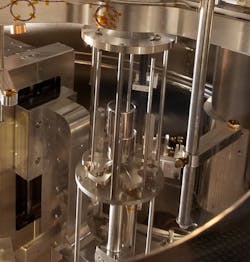Researchers at the National Institute of Standards and Technology (NIST) have made their most precise determination yet of Planck’s constant. This will let NIST redefine the kilogram, the official unit of mass in the SI, or international system of units, in terms of fundamental constants of nature rather than exemplars. (The kilogram is currently defined as being equal to the mass of a platinum-iridium artifact stored in France.)
The new NIST measurement of Planck’s constant is 6.626069934 x 10−34 kg∙m2/s, with an uncertainty of only 13 parts per billion. NIST’s previous measurement, published last year, had an uncertainty of 34 parts per billion.
Planck’s constant lets researchers relate mass to electromagnetic energy (E=hν). To measure Planck’s constant, NIST used a Kibble balance. It uses electromagnetic forces to balance a kilogram mass. The electromagnetic forces come from a coil of wire sandwiched between two permanent magnets. The balance has two modes of operation. In one mode, an electrical current goes through the coil and generates a magnetic field that interacts with the permanent magnetic field and creates an upward force to balance the kilogram mass.
In the other mode, the coil is lifted at a constant velocity. This upward motion induces a voltage in the coil proportional to the strength of the magnetic field. By measuring the current, voltage, and coil’s velocity, researchers can calculate Planck’s constant, which is proportional to the amount of electromagnetic energy needed to balance a mass.
There are three major reasons for the improvement in the new measurements, says physicist Stephan Schlamminger, leader of the NIST effort.
First, researchers have much more data. The new result is based on 16 months’ worth of measurements, from December 2015 to April 2017. The increase in experimental statistics greatly reduces the uncertainty in their value for Planck’s constant.
Second, the researchers tested for variations in the magnetic field during both modes of operation and discovered they had been overestimating the affect the coil’s magnetic field had on the permanent magnetic field. Their subsequent adjustment in their new measurements both increased their value of Planck’s constant and reduced uncertainty in their measurements.
Finally, the researchers studied in great detail how the velocity of the moving coil affected voltage. “We varied how fast we moved the coil through the magnetic field, from 0.5 to 2 millimeters per second,” explains Darine Haddad, lead author of the NIST results.
In a magnetic field, the coil acts like an electric circuit consisting of a capacitor (a circuit element that stores electric charge), a resistor (an element that dissipates electrical energy), and an inductor (an element that stores electrical energy). In a moving coil, these circuit-like elements generate an electrical voltage that changes over time. Researchers measured this time-dependent voltage change to account for this effect and reduced the uncertainty in their value.
This new NIST measurement joins a group of other recalculations of Planck’s constant measurements from around the world. Another Kibble-balance measurement from the National Research Council of Canada has an uncertainty of just 9.1 parts per billion. Two other new measurements use the alternative Avogadro technique, which involves counting the number of atoms in a pure silicon sphere.
The new measurements have such low uncertainty that they exceed the international requirements for redefining the kilogram in terms of Planck’s constant.
There need to be three experiments with uncertainties below 50 parts per billion, and one below 20 parts per billion to redefine the constant. Currently, there are three measurements with errors below 20 parts per billion, so redefinition is in order.
All of these new values of Planck’s constant do not overlap, but overall they’re in amazingly good agreement, especially considering researchers came up with them using two completely different methods. These values will be submitted to CODATA, the Committee on Data of the International Council for Science, which promotes global collaboration to improve the availability and usability of data for all areas of research. That group will consider all of these measurements in setting a new value for Planck’s constant. The kilogram, along with other SI units, is slated for redefinition in November of next year.


